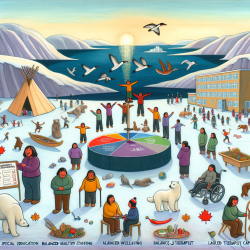Unlocking the Secrets of the Adult Inuit Health Survey: A Guide for Practitioners
The Adult Inuit Health Survey (IHS) 2007–2008 offers a treasure trove of insights for health practitioners and researchers. Conducted across the Canadian Arctic, this survey provides baseline data essential for understanding the health status and living conditions of the Inuit population. As a practitioner, integrating these findings into your practice can enhance your understanding and improve your service delivery to Inuit communities.
Why the Adult Inuit Health Survey Matters
The survey, part of the Canadian International Polar Year program, was a comprehensive effort involving 33 coastal and 3 inland communities. It aimed to gather data on chronic diseases and health indicators among the Inuit. The survey's findings are pivotal for developing future health policies and public health interventions tailored to the unique needs of the Inuit population.
Key Takeaways for Practitioners
- Participatory Research: The survey emphasized a participatory research process, involving extensive consultations with community representatives and stakeholders. Practitioners should adopt similar approaches, ensuring community involvement in health initiatives.
- Ethical Considerations: The IHS employed innovative methods like visual consent forms to accommodate Inuit oral traditions. Practitioners should consider culturally appropriate consent processes in their work.
- Comprehensive Data Collection: The survey's robust methodology included random sampling, detailed questionnaires, and clinical measurements. Practitioners can draw on these methods to enhance their data collection techniques.
- Knowledge Translation: The IHS prioritized disseminating findings to communities before public release. Practitioners should ensure their research and findings are accessible and beneficial to the communities they serve.
Opportunities for Further Research
The Adult IHS provides a foundation for future research, offering opportunities to link with the International Inuit Cohort for longitudinal studies. Practitioners are encouraged to explore these data further to identify trends and factors contributing to health disparities among the Inuit.
Conclusion
By integrating the insights from the Adult Inuit Health Survey into practice, health practitioners can better address the unique challenges faced by Inuit communities. This survey not only highlights the importance of culturally sensitive research but also sets the stage for future health interventions and policies.
To read the original research paper, please follow this link: Design and methods of the Adult Inuit Health Survey 2007–2008.










